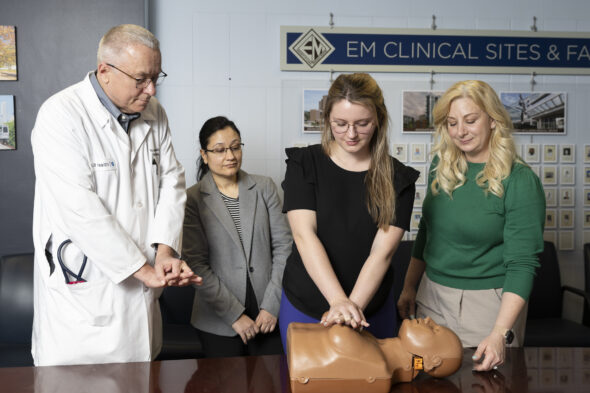Chicagoans are dying from cardiac arrest outside the hospital at increasingly younger ages

The mean age at which people in Chicago have fatal heart attacks outside the hospital is getting younger, with the biggest changes happening among Black men, according to a new study led by the University of Illinois Chicago and Illinois Heart Rescue.
The study — the first that the authors know of that looks at this issue on a community level — analyzed data of over 21,000 cases from Chicago Emergency Medical Services from 2014-21. They found that the average age for cardiac arrest outside the hospital fell from 64.7 during 2014-15 to 62.7 during 2020-21. The average age for men fell more than for women, and the average age for Black adults fell more than for white adults. The study is published in the CDC’s Morbidity and Mortality Weekly Report.
At first, the researchers thought the trend might be related to COVID-19. But after diving deeper into the data, “it was very clear that this started pre-pandemic,” said Shaveta Khosla, director of emergency medicine research at UIC and lead author on the study. “The pandemic may have exacerbated it, but it was happening previously.”
The study did not identify the trend’s cause, and the researchers plan to do further studies to investigate that question.
The current study began after Khosla noticed a few papers indicating that people who experienced a cardiac arrest in the hospital were getting younger, but she couldn’t find any information on similar trends for cardiac arrests outside the hospital. Cardiac arrests that happen outside a hospital are almost always fatal — about 90% of people who experience one die from it, the authors write.
To demonstrate the impact of these earlier deaths, the authors quantified at the city level how many additional potential years of lost life occurred as the average age of cardiac arrest fell. They found that, overall, the years of potential life lost increased by 71% from 52,044 in 2014-15 to 88,788 in 2020-21. For Black adults, the number rose by 75%.
These additional years of lost life mean that people not only leave behind grieving friends and family but are also losing years when they could have been working to support their families and communities, explained Dr. Terry Vanden Hoek, professor of emergency medicine at UIC and senior author on the study. “These are productive years that are lost,” he said, adding that the trend is disproportionately impacting Black Chicagoans. “This is a health equity issue.”
The researchers hope their results will inspire others to conduct similar studies in other communities. The team would also like to examine trends at the national level.
Even without further research, there is clearly a need for increased community outreach to both treat cardiac arrest risk factors, such as high blood pressure, and to train people in how to respond if they see someone in cardiac arrest, Vanden Hoek said. UIC and Illinois Heart Rescue are doing this by going into community settings like churches and schools to teach bystander CPR, and he sees an opportunity to add information to these sessions in the future about how people can reduce their own risk of cardiac arrest.
The other authors on the paper are Dr. Pavitra Kotini-Shah at UIC, Dr. Marina Del Rios at the University of Iowa and Dr. Joseph Weber at John H. Stroger Jr. Hospital. The work is funded by the Illinois Heart Rescue Program.
